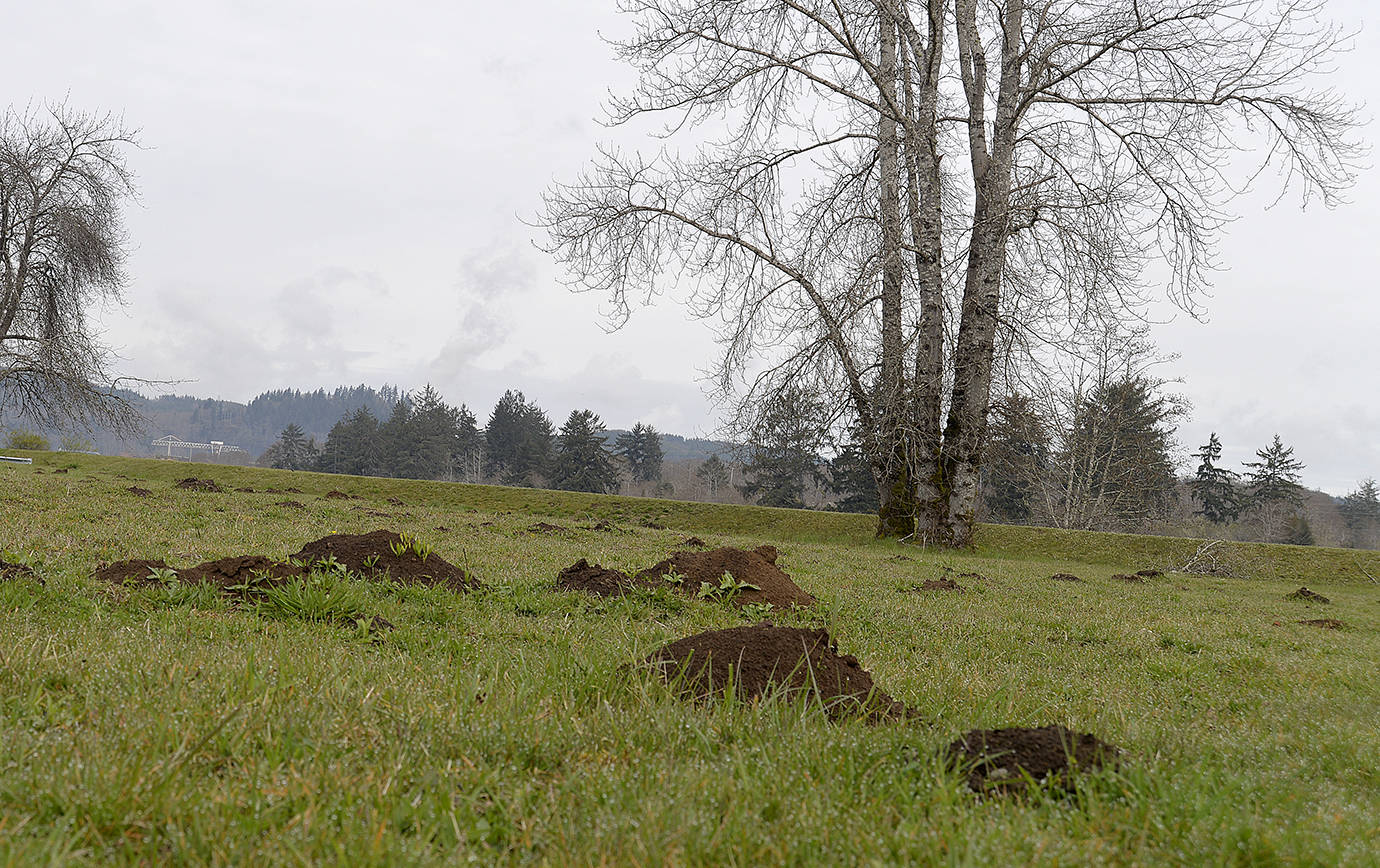Not to make a mountain out of a mole hill, but moles really can do a number on lawns and gardens across Grays Harbor County.
One notable and highly visible spot that perfectly highlights the damage these critters can do is on U.S. 101 in Cosmopolis, a chunk of property riddled with mole hills along the Chehalis River owned by Weyerhaeuser across the street from Advanced Heating and Air. So much so somebody recently posted a sign at the edge of the property reading, “Chehalis National Mole Refuge.”
WSU Extension master gardener and frequent contributor to The Daily World Mary Shane said she has a neighbor who has said on more than one occasion, “No better sight than a dead mole!” Some desperate landowners are still using body-piercing or gripping traps to get rid of the pesky critters, one set at each mound, despite the fact those traps have been illegal since an initiative was passed in 2000 to ban such devices.
“A friend of mine recently had a Facebook post with a picture of her lawn with mole mounds and requested remedies,” said Mason County Master Gardener program coordinator Jeannine K. Polaski. “It was pretty interesting to see the variety of techniques people used to get rid of moles. I thought the strangest one was the recommendation of pouring gasoline down the hole. I am guessing that while it may have killed the moles, it probably didn’t help the overall health of the lawn or any other animals around the area! Not to mention the safety hazard it might present!”
So, if you want to keep moles from ripping up your yard and garden and want to follow the letter of the law and not blow up the neighborhood, how do you get get rid of these pests? Shane and Polaski both referred to David Pehling, an extension educator with the WSU Extension in Snohomish County, who has authored papers on the habits of moles in western Washington and is the go-to guy when it comes to mole control.
According to Pehling, moles are solitary creatures who like to tunnel in previously tilled or disturbed ground, where the digging is easier. They can live up to three years in the wild and the females can birth up to four young in the early spring annually. When the offspring are ready to strike out on their own after about four weeks, they will seek out their own property to ruin, sometimes adjacent to their mother’s. When a mole dies, others will take over its tunnels.
It’s tempting to stomp molehills flat, because, let’s face it, they’re irritating. But Pehling said when you do that, the moles will simply push the dirt back up to reopen the tunnel. It fixes nothing.
Pehling’s first suggestion when it comes to mole control is to take a “live and let live” approach. While unsightly, mole hills don’t do a lot of structural damage to your property. Occasionally their tunnels can be a conduit to other critters like voles and rats that can damage plants and other vegetation, but moles themselves generally eat worms and grubs, not plants. And by spreading out the dirt displaced by moles or removing it altogether, a yard or garden can recover.
If the live and let live option isn’t a feasible one – for instance, if you have horses or other animals who could be injured by stumbling into a mole hill – there are other, legal options, according to Pehling.
Fencing: While labor-intensive and not effective on larger properties, installing a barrier to moles can work on small gardens and lawns. Dig a ditch 18-24 inches deep and install a vertical barrier of aluminum sheeting of 1/4-inch mesh galvanized hardware cloth. When possible, leave six or so inches of the material above ground. Moles will occasionally burrow around the barrier, and it won’t take care of the moles already present in the area, but it’s a decent option to prevent new infestation.
Stomp and strike: During peak mound building times, usually in the spring and fall, stomp down the mole hills and keep watch over them. When you see the dirt being disturbed that means your mole is attempting to clear its tunnel. Take a shovel, quickly dig up the mole and kill it with a whack to the head. Dirty work, but gets the job done.
Flushing: Dump buckets of water down active mole hills to try to force the miles above ground. This doesn’t work as well in sandy soils.
Baits: There are various poisons available but their effectiveness is described as inconsistent, and when it does work it can sometimes take weeks of treatment. They are called poisons for a reason: According to the National Pesticide Information Center, phosphine- and bromethalin-based mole baits can be deadly to pets and humans if ingested, and predatory birds can be poisoned if they prey on poisoned moles. If you choose to use this method, Pehling said it is very important to follow all label directions when using poisonous baits.
Smoke bombs: Work best in dense or water-saturated soils.
What about traps? Voters banned the use of body-gripping and body-piercing traps through initiative in 2000. The ban included commonly used mole traps, which are now legal to own but not to use. And live traps rarely work, and it is also illegal to take any wild animal, even a mole, and relocate it to another property.
Pehling said taking an integrated approach to mole control is the best bet, meaning using a combination of the above methods. It’s also important to monitor the property before beginning physical or chemical treatments. Punch some holes along the mole tunnel system and in the mounds, then check back to see which holes have been repaired. Focus your efforts on that area.


